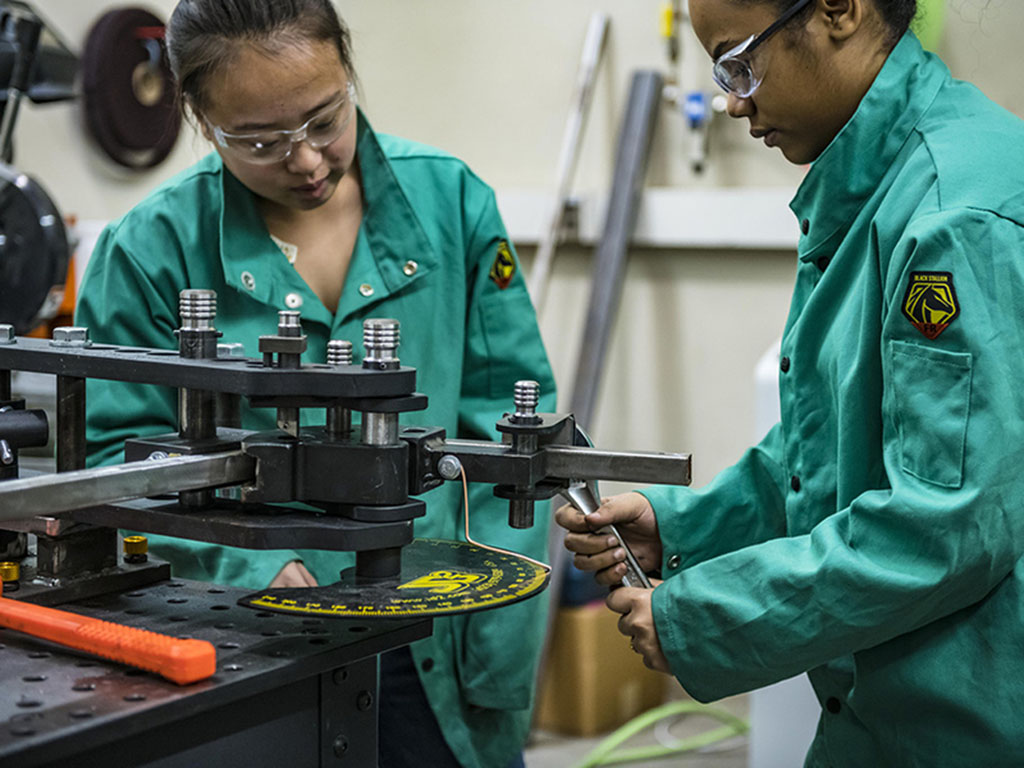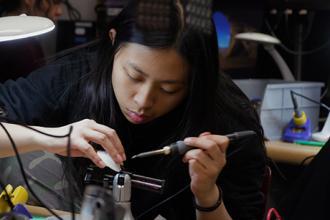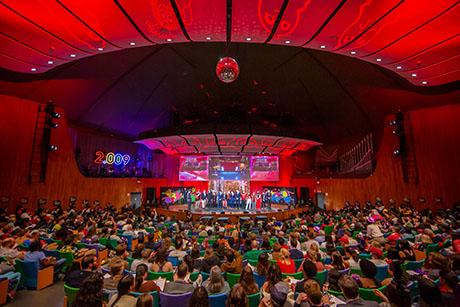Training manufacturing technologists to be future shop floor leaders
In higher education, MIT is best known for its world-class programs for undergraduate and graduate students. In addition, MIT’s Professional Education, MITx, and MITxPro, among others, have reached new audiences worldwide with MIT-caliber offerings. So have summer programs such as MIT Lincoln Laboratory’s BeaverWorks Summer Institute.
A new curriculum in development at MIT may soon open up learning opportunities for a new population of students — workers who are not necessarily college bound — to gain exposure to advanced technologies and industry-relevant expertise.
With collaborators at the University of Massachusetts at Lowell, Clemson University, Cape Cod Community College, and in the future the manufacturing software firm Tulip, a group of MIT researchers is developing a new curriculum aimed at strengthening the nation’s manufacturing workforce. The project was recently awarded funding from the U.S. Department of Defense (DoD)’s Innovation Capability and Modernization (ICAM) office and its Industrial Base Analysis and Sustainment (IBAS) program.
In the manufacturing field, many students are natural tinkerers or standouts in their jobs, but aren’t seeking a four-year degree. The new curriculum, aimed at workers holding an associate’s degree or equivalent, will aim to build on their technical know-how by blending it with an engineer’s perspective on systems and processes.
"With increasing technological sophistication, the quickening pace of technology change, and ever-tightening standards, we need to incorporate quality education into manufacturing training programs," says John Liu, an MIT lecturer, co-principal investigator for the project, and director of MIT’s Learning Engineering and Practice Group. "By integrating MIT's mind-and-hand approach to how we develop the manufacturing workforce, we can re-energize America’s factory floors, empower companies to move into advanced manufacturing, and support firms in adopting advanced manufacturing technologies.”
After talking to large and small companies, schools, workforce boards, manufacturing extension programs, and education and workforce experts, a team led by Liu and affiliated with the Manufacturing@MIT Working Group discovered a gap in training that Liu felt he could address. Many vo-tech schools and community colleges offer programs to help students fill technician roles. Companies, too, train technicians, some of whom they hire with no manufacturing background. No one, however, had a clean solution to give technicians a ladder to become shop-floor leaders; “technologists” would bridge the gap between technicians and engineers.
“Advanced manufacturing will not work unless it integrates production in new ways. This new program aims to educate a new kind of factory systems leader to undertake this,” says Bill Bonvillian, senior director of special projects for MIT Open Learning and a key member of the MIT team behind the technologist program. Bonvillian is coauthor of the book “Workforce Education: A New Roadmap.”
Earlier, Liu had facilitated the creation of the MITx Principles of Manufacturing Micromasters, which covers processes, systems, supply chains, and management of manufacturing. Dave Hardt, MIT professor of mechanical engineering and the Ralph E. and Eloise F. Cross Professor in Manufacturing, along with other faculty in the MIT Master of Engineering in Advanced Manufacturing and Design (MEng) program distilled these four “principles of manufacturing” so they might be applied to any industry in manufacturing. Liu felt these same skills would be valuable for technicians who wanted to become shop-floor leaders, and that the new project team could create a new curriculum, but for a different audience. This material would go into the “hub” of the technologist curriculum. The team would then also build “spoke” material, in areas like robotics, additive manufacturing, and advanced CNC machining.
The technologist program fits a major need in advanced manufacturing. While engineers are trained in design, technicians are trained to operate particular processes, such as CNC machining or welding. Yet advanced manufacturing requires a new level of expertise — technologists who understand the systems on the factory floor, who can integrate the new technologies like robotics or additive manufacturing along with existing equipment, and apply data analytics to make the new system highly efficient. While engineers design and technicians operate, the technologist would be a bridge. Liu and Bonvillian make the case for this new technologist occupation in a new article published by Issues in Science and Technology, a policy journal of the National Academies of Sciences, Engineering, and Medicine.
“The technologist program will be a major contribution to advancing the manufacturing workforce, which is arguably the greatest need of manufacturing companies of all sizes in the United States. It’s also a great example of collaboration between MIT, other institutions, industry, and government, and aligns incentives among stakeholders to create meaningful impact," says John Hart, who is head of the MIT Department of Mechanical Engineering, co-director of the Manufacturing@MIT Working Group, and the PI for MIT’s part of the DoD-funded technologist program. “Manufacturing technologists will have exciting, advanced technology careers, and the IBAS program funding is instrumental in launching this program. It is an important opportunity for MIT, and our team led by Dr. John Liu and our collaborators, to extend MIT’s leadership in manufacturing education in a new realm,” explains Hart, who is also director of the Laboratory for Manufacturing and Productivity and director of the Center for Advanced Production Technologies.
The DoD’s ICAM office is supporting the multi-institutional project led by UMass Lowell with a $4.25 million investment over two years. MIT’s contributions to the program are supported by $3.09 million in DoD funding via a two-year subaward. Adele Ratcliff, ICAM office director, says, “The University of Massachusetts Lowell and MIT are creating a one-year advanced manufacturing technologist certificate curriculum and content aligned with our defense manufacturing industry needs. This technologist education will help with huge shortages in skilled labor facing many defense companies supporting critical manufacturing technologies for years to come. The technologist program is a natural blending of 2-year and 4-year manufacturing and engineering programs and curricula that is being driven largely by Industry 4.0 in the digital age, keenly recognizing the need to help foster that evolution.”
Collaborators at Clemson University will help design and build virtual reality simulations for the program, so students who might not have access to cutting-edge equipment can learn using virtual tools.
“Our goal at Clemson University is to create transformative learning experiences where students and incumbent workers, regardless of their access to state-of-the-art equipment, can engage with virtual digital learning tools. This initiative of reskilling and upskilling opportunities for all is essential to bolster U.S. competitiveness in an ever-evolving technological landscape," says Kapil Chalil Madathil, the Wilfred P. Tiencken Professor of Industrial and Civil Engineering at Clemson University, director of the Clemson University Center for Workforce Development, and the PI for Clemson University’s part of this DoD-funded technologist program.
The Manufacturing@MIT Working Group is coordinating with an advisory council of several New England community colleges that would be ready to offer a year-long, blended-learning program, and when the curriculum is ready it will continue to seek funding to support the program’s rollout. Manufacturing@MIT has also collected scores of letters from companies that say they would be ready to pay a wage of at least $25 an hour to graduates of such a program.
“The new certificate program will help develop critical thinking and practical skills,” says Brad Mingels, director of workforce development for professional and undergraduate education at the Francis College of Engineering at the University of Massachusetts Lowell. “It should also help graduates advance in their careers and move on to more education and higher-paid jobs.”
Indeed, companies have told the Manufacturing@MIT group that not only would graduates of the technologist program provide a bridge between technicians and engineers, but they would also bring new, advanced manufacturing know-how to their factories. The education, toolsets, and mindsets that graduates will take away from the program will empower them to share their ideas, so those ideas might “bubble up” to companies’ engineers and management. The program will empower workers who faced opportunity and education gaps.
Alongside ICAM’s IBAS-funded program, Manufacturing@MIT is also working to scale its collaborations with companies and community colleges across the country. Individuals seeking more information can contact John Liu.
Now the work will begin to build the curriculum, which MIT and UMass Lowell plan to ultimately offer for free to any community college, company, or military production facility (including shipyards and arsenals) that wants to educate the next generation of technologists to become shop-floor leaders.




